14 Ingredient Swaps That Will Make Potato Salad So Much Better
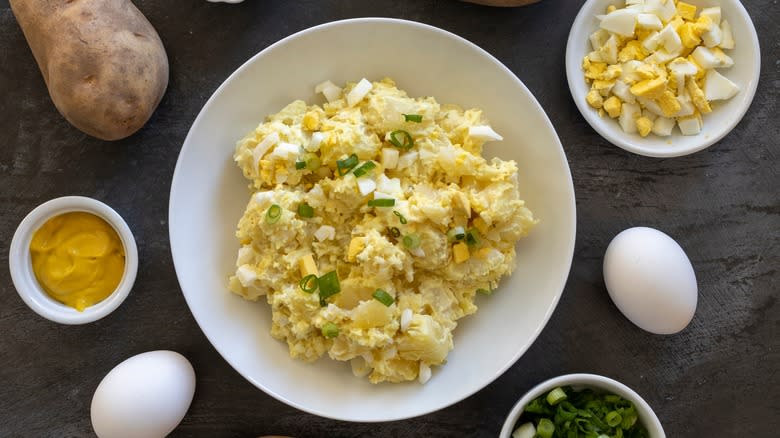
How do you improve on potato salad? Many will say that it can't be done. This classic side dish follows a standard recipe for a reason, with its combination of cooked potatoes, mayonnaise, mustard, celery, and seasonings coming together time and time again because it just tastes so darn good. However, we're of the opinion that potato salad needs a little revamp, and one of the easiest ways to freshen this dish up is to hit it with some ingenious recipe swaps.
We're not just suggesting this for the sake of it, y'all. Swapping key ingredients in potato salad can amp up certain flavor dimensions of the dish, giving it additional pops of acidity and extra richness. Other swaps can bring out sweet notes without resorting to adding granulated sugar, while others give your potato salad a spiciness and smokiness that cuts through its density. Oh, and did we mention that you can even swap out the potatoes for other ingredients -- and make things even more delicious when doing so? Check out all the ways you can amp up your potato salad right here.
Read more: 7 Bacon Brands You Should Buy And 7 You Might Want To Skip
Swap Mayo With Blue Cheese Dressing For Extra Sharpness
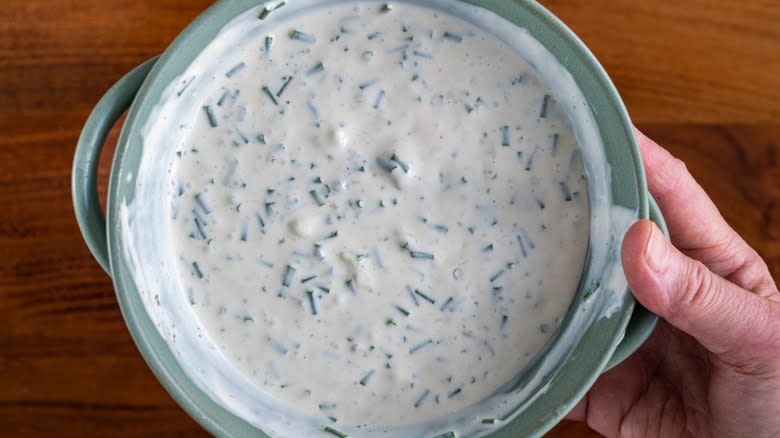
It can feel a bit sacrilegious to suggest swapping mayonnaise for something else in potato salad. After all, the creamy condiment is so often the base of this dish, giving the salad body and smoothness. If you want to take things to the next level, though, blue cheese dressing is the secret ingredient you need. By using blue cheese dressing, you give potato salad an added tang and sharpness that mayonnaise doesn't provide, while still binding your potatoes and other ingredients together.
Blue cheese dressing also packs some saltiness into potato salad, allowing you to worry less about seasoning it. It pairs particularly well with mustard and vinegary notes, too. You can also improve your own simple blue cheese-infused dressing by mixing blue cheese crumbles into your standard mayo. Doing this will give your potato salad extra pops of chewiness and a funky flavor, and allows you to control exactly how much cheesiness your salad contains. Bear in mind that blue cheese can vary significantly in intensity, so make sure you taste your chosen chunk before you start crumbling it into your mayo.
For A No-Potato Potato Salad, Use Rutabaga
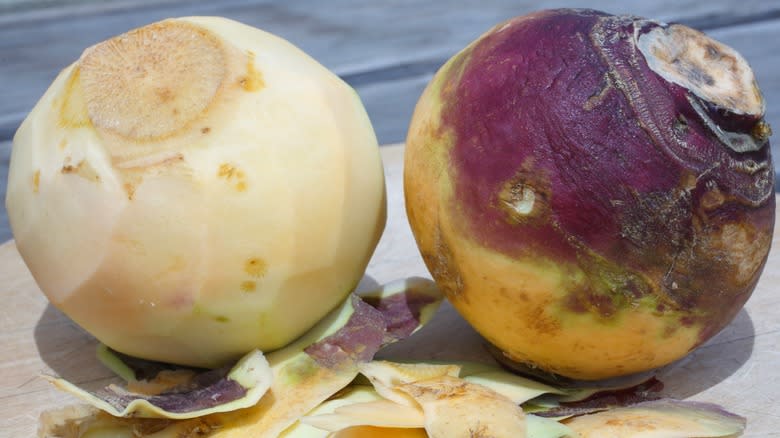
A potato salad made without potatoes? Amazingly enough, it can be done! For a low-carb alternative to your classic salad, skip the potatoes and use rutabaga instead. Rutabaga (or swede) is the perfect alternative to potatoes in this salad due to its potato-like flavor, and as such it gives you a keto-friendly option for your main component without changing things up too much. Having said this, you might notice that rutabaga has a mild sweetness to it that potatoes don't have.
This mild sweetness isn't necessarily an issue: It can brighten up your salad and contrast the more savory notes in it perfectly, rounding out the flavor of the overall dish without you having to use another sugar source. If you are picking rutabaga to fit into a low-carb or keto diet, though, it's worth remembering that it still has some carbs in it (roughly 8 grams per 100 grams of vegetable). You should also keep in mind that other additions to your potato salad can negate its effect. Some brands of light mayo can contain more carbs than you might think, with additional ingredients added to replace the flavor lost from the lower fat content, and certain seasoning blends can contain sugar -- so make sure you're checking your nutritional labels thoroughly.
Rather Than Onions, Use Leeks
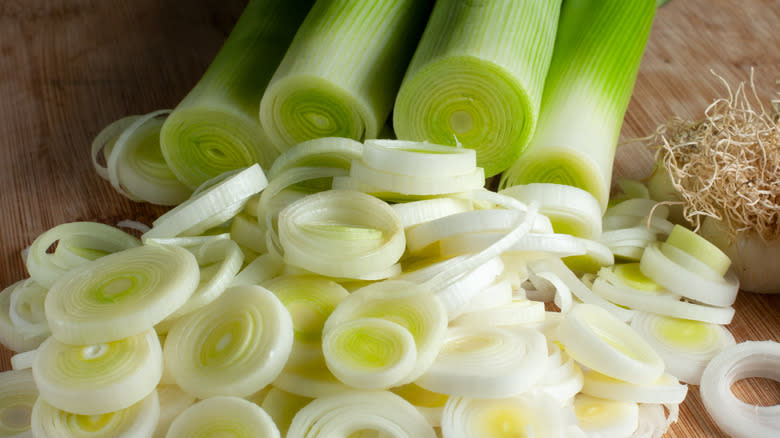
For a lot of people, onions are a key ingredient in potato salad. This reliable root vegetable gives potato salads an acrid note, cutting through their density with some much-needed sharpness. However, there are times when the taste of raw onion can be a little too punchy, and if you want the same savoriness without things getting too acidic, use leeks instead.
Leeks have a milder, slightly more floral flavor than onions, without any of the intense bite. They can also be slightly softer than onions, while still retaining a snappy bite that gives potato salad some much-needed textural contrast. Leeks are also pleasingly simple to slice up, with their long, round shape allowing you to prepare them for use in your salad in mere seconds. You can use both the white and green parts of the leek in potato salad, although bear in mind that the top of these plants can get a bit fibrous and tough. If you want to give your potato salad even more depth, try sautéing your leeks gently in a little butter before allowing them to cool completely. This will develop their flavor and bring out their natural sweetness.
Swap Paprika With Cajun Seasoning For Additional Depth
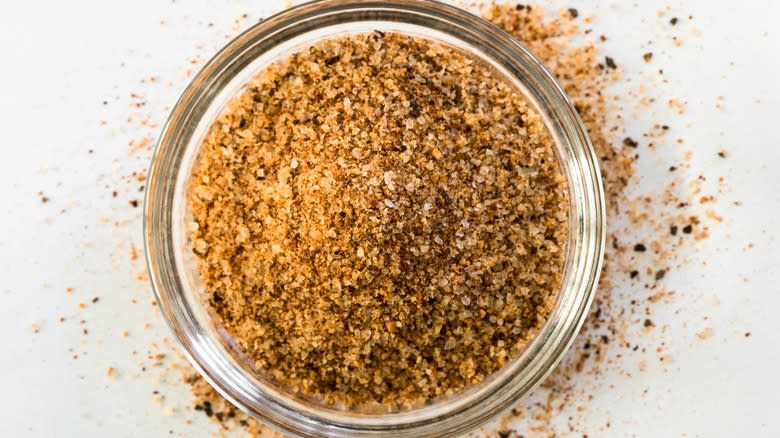
A lot of potato salad recipes contain paprika, either mixed directly into the dressing or used as a garnish at the end for a pop of color. No matter how it's used, paprika provides the salad with a smokiness and a savory note that lifts it from being incessantly creamy. However, just using a single spice can be a touch one-note. To unlock even more flavors, swap your paprika with Cajun seasoning.
Cajun spice seasoning can elevate many foods with its combination of paprika, cayenne pepper, onion and garlic powder, and salt and pepper. The cayenne content gives it an added spiciness that plays well with the creamy dressing, while the onion and garlic powder provide an element of savoriness, deepening the flavor of the salad. Many Cajun spice blends can also have an herbal element like thyme, which adds brightness and a fragrant scent. If you're using Cajun seasoning, make sure you're not adding too much salt elsewhere: They can be quite salty, and your mayo will have salt added to it too. You should also make sure it has enough time to fully release its flavors into the dressing before you serve the salad.
Instead Of Mayo, Use A Vinaigrette

If you want to make your potato salad extra special, you might have to make the biggest sacrifice of all: Removing the mayo entirely. We know, we know, it sounds pretty wild. However, it's worth remembering that creamy potato salad isn't the only type of potato salad out there. Austrian potato salad is a common accompaniment to Wiener Schnitzel, and it contains no mayo at all, with the dressing instead coming from a combination of oil, vinegar, and mustard. You can replicate this easily at home, and lighten up your potato salad by using these key ingredients, producing a vinaigrette-based salad that's devilishly easy to eat.
You can either make your own vinaigrette or use a bottled version -- the choice is yours. If you want to keep things authentic, try and keep your vinaigrette as basic as possible, using good-quality apple cider vinegar and premium olive oil. Dijon mustard will give you that rich, immediate sharpness, but you can also use whole-grain or English mustard if you prefer. If you want to deepen the flavors in your dish, you can also use a balsamic-based vinaigrette or one made with red wine vinegar.
Swap Eggs With Tofu For A Plant-Based Twist
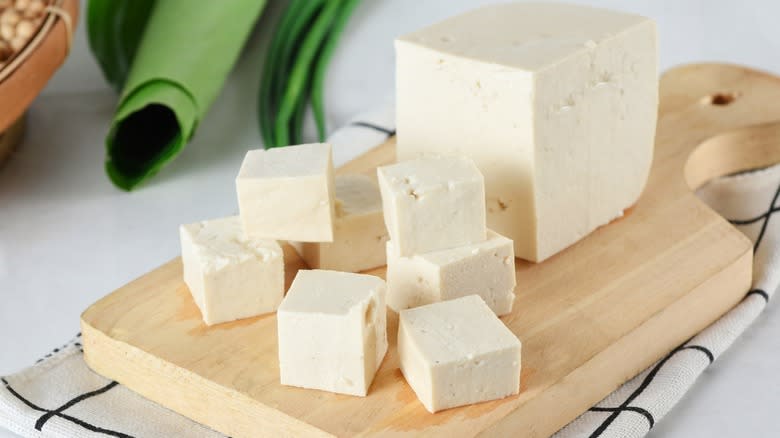
If you haven't had potato salad with pieces of sliced egg in it, you're missing out. When used sparingly -- we want this to be a potato salad and not an egg salad, after all -- eggs can give your potato salad some much-needed protein and make the whole dish way more filling. Eggs can also provide an added creamy note, and they take well to virtually any seasoning you want to add.
There's something just as good as eggs in potato salad, however: Tofu. A perfect substitute for a plant-based potato salad, tofu provides all of the powerful protein and gentle creaminess that eggs do, and also gives your salad a slightly nutty note. Tofu also pairs effortlessly with the chosen flavor profile of your dish, and works just as well in creamy potato salads as it does vinegary ones.
Tofu comes in many shapes, sizes, and levels of firmness. You'll want to find extra-firm tofu to use in your egg salad, to ensure it holds its shape and gives you a good amount of bite. If your tofu is a little loose, press it gently for around 30 minutes using consistent pressure to squeeze out any excess water.
To Speed Things Up, Swap Your Potatoes With Gnocchi
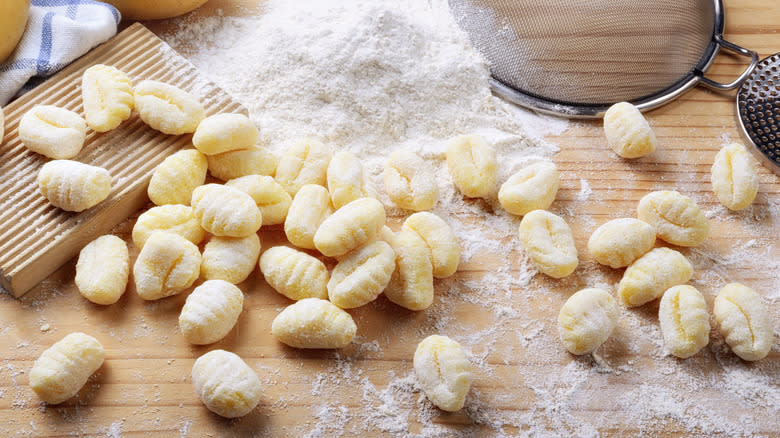
Potato salad isn't one of those dishes that takes forever, but it can take longer than you think. The majority of your time will likely be devoted to waiting for your potatoes to cook before you can dress them. If you want to significantly cut down on this step, skip the potatoes entirely and use gnocchi. These potato-based dumplings will give you all of potato's neutral, adaptable flavor and texture, and they take just a few minutes to cook. As an added benefit, you don't have to worry about chopping: Every piece of gnocchi is already perfectly bite-sized.
It's useful to remember that swapping gnocchi for potatoes will give you a potato salad with a slightly chewy texture, because of the dumplings' flour content. This flour content can also mean that gnocchi can be slightly gummy when cooked, and this gumminess, when combined with mayonnaise, can get a bit overbearing. It can be a good idea to use a slightly lighter dressing when making gnocchi potato salad, or switch things up entirely by introducing some brand new flavors -- pesto potato salad, anyone?
Rather Than Celery, Opt For Green Bell Pepper
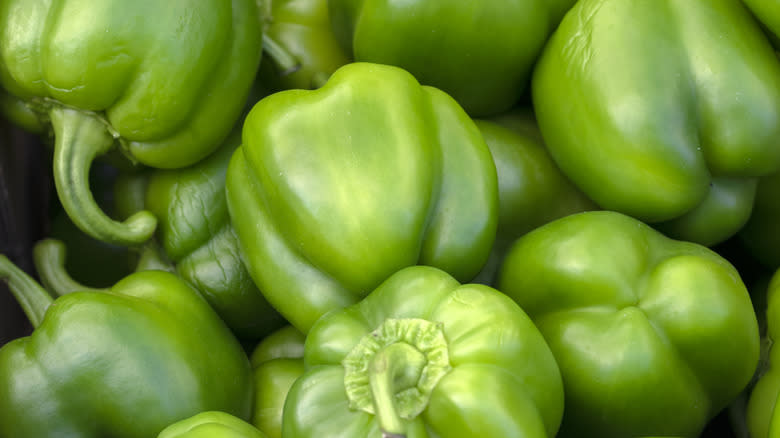
If you're not careful, potato salad can quickly become a mass of mush, with nothing to really get your teeth into. Celery is usually the ingredient that counteracts this, and, when diced into fine pieces, it gives potato salad crunch and a vegetal flavor. If you want to amp both your flavor and your crunch factor up a notch, though, use green bell pepper. Green bell pepper gives your potato salad a snappy, sweet-sour flavor that pairs well with its standard seasonings and is especially good for spicier salads that incorporate Cajun tastes.
If you want to add more color to your potato salad, don't just stop at green. Grab yourself some red or yellow bell peppers and throw them in too. Red bell peppers have a slightly sweeter flavor, thanks to being more ripe, and they're a great way to add some gently sugary notes to the salad without using an added sweetener. Yellow bell peppers are a little less sweet, with green bell peppers being the most bitter. Mixing them all up, though, will help balance out their individual flavors.
Horseradish Makes For A Fiery Mustard Substitute
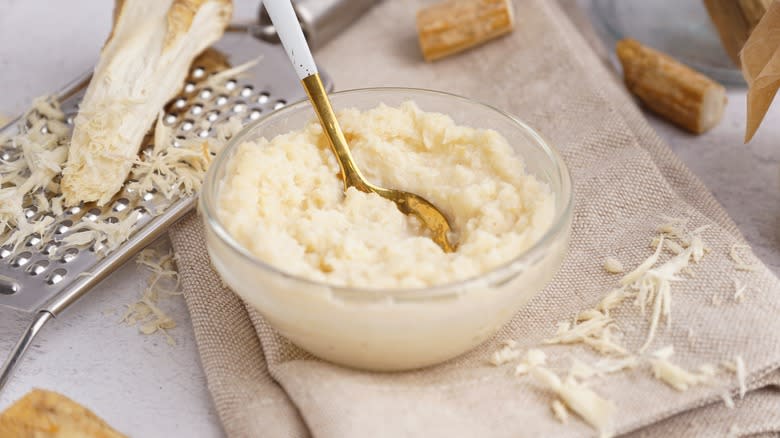
If it's not made correctly, potato salad can be mind-numbingly boring. One of the easiest ways to avoid this is by adding a pop of mustard into the mix, which gives it some much-needed warmth and sharpness, as well as a gloriously yellow tinge. If mustard's not enough for you, though, try using horseradish instead. Horseradish has a pungent, spicy flavor, with a strong resemblance to mustard (which is hardly surprising, considering it's actually an ingredient in some hot mustard recipes). When added to recipes in sufficient quantities, it produces the same nasal-burning intensity.
If you're new to horseradish, it's best to add less than you think. Even a tiny bit too much can tip the scale and make your food barely edible. While you can use fresh horseradish by grating it using a Microplane, newbies will likely be more comfortable using the jarred, pre-prepared kind. Jars of horseradish are pretty easy to find, and usually contain a combination of the spicy root and salt, sugar, and vinegar. This helps to balance out its fiery flavor, stop it from blowing your head off, and give it more complexity.
To Add Richness, Use Sour Cream Instead Of Mayo
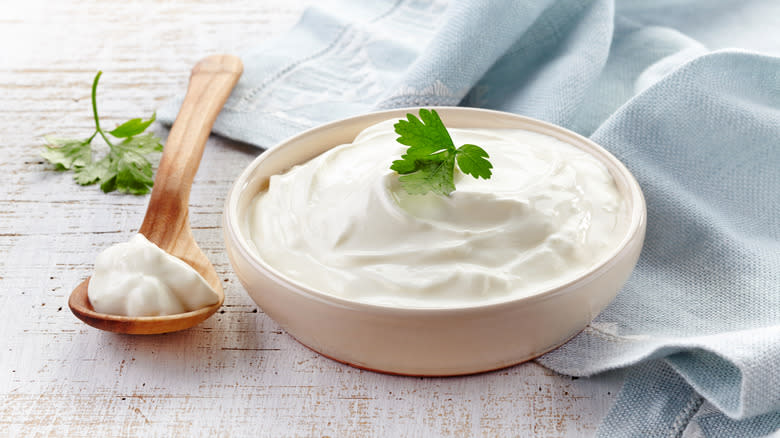
You might not think you'll get far with potato salad without mayo, but you'd be mistaken. There are a fair few ingredients that we think are even better in potato salad than the standard condiment, and sour cream is one of them. Sour cream is dairy-based, and so has a note of milky richness that mayonnaise just doesn't quite provide. At the same time, it also gives your potato salad a tangy edge that's similar to mayo, but somehow feels fresher on the tongue.
Sour cream also has a dense, chunky thickness to it, which means that it provides the same structural benefits that mayo does. Like mayonnaise, it absorbs the flavor of various seasonings and additions well. It's worth mentioning that a lot of sour cream's richness comes from its fat content, so folks who are used to using low-fat mayo for their potato salad might be surprised by how full it tastes. If you want to strike a balance between the two, don't be afraid to mix your sour cream with mayo: The two go well together, with their acidic notes complementing each other.
Opt For White Pepper Instead Of Black Pepper
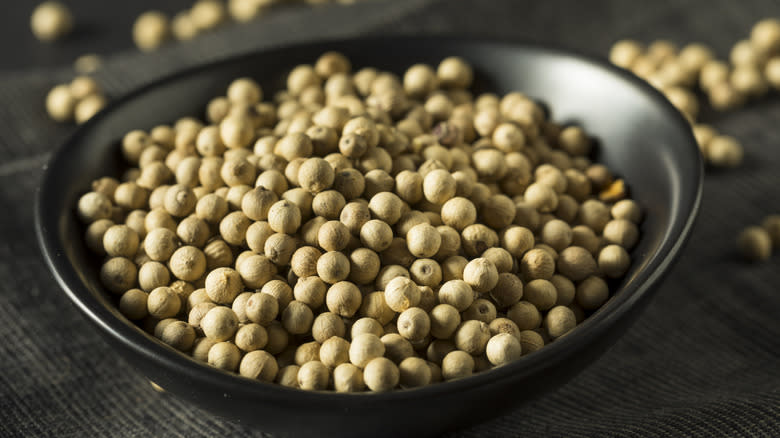
What's potato salad without black pepper? Not much, in our opinion. Black pepper adds an all-important spiciness to the dish, which cuts through its creamy density and lightens it up somewhat. For folks who don't want to spend their afternoon fishing chunks of black pepper out of their teeth, though, or want a slightly lighter spice, white pepper is the way to go.
White pepper is sort of black pepper's gentle counterpart; instead of a musky scent, it has a more perfumed edge and an almost tangy taste. However, you need to be careful with it. Although white pepper is a little more subtle than black pepper in small quantities, if you add too much it can really start to overpower your dish, and cause a nose-tickling spice that quickly initiates a sneezing fit. As its spice develops over time, you'll likely want to add just a small amount to begin with, and then do a taste-test once it's had a chance to diffuse and deepen. You can also use a combination of black and white pepper for maximum complexity; just make sure to use half of each, instead of adding double your quantities of pepper.
Don't Have Any Potatoes? Use Cauliflower Instead

Sometimes you're craving potato salad, but don't necessarily want the bulk that it brings to the table. Other times, you simply want to enjoy the dish but not have to think about the carbs. In both of these situations, using cauliflower instead of potatoes is the way to go. When cooked, cauliflower has a subtly earthy taste that's surprisingly similar to potatoes, and which pairs well with the sharp richness of your dressing and added seasonings. It's also easy to chunk up into small bites, and bears a striking visual appearance to potatoes -- your guests may not even be able to tell the difference.
Like with potatoes, you'll want to be careful with how much you cook your cauliflower. Boiling or steaming it for just a few minutes too long can make it overly soft and unappealing, and you run the risk of your potato salad turning into mash. Instead, cook it until it's fork-tender, but retains a gentle bite. Once you add it to your dressing, give your cauliflower some time to absorb all the flavors, which will help to take away its slightly vegetable-heavy top note.
Swap Celery For Corn, And Get Brightness And Crunch
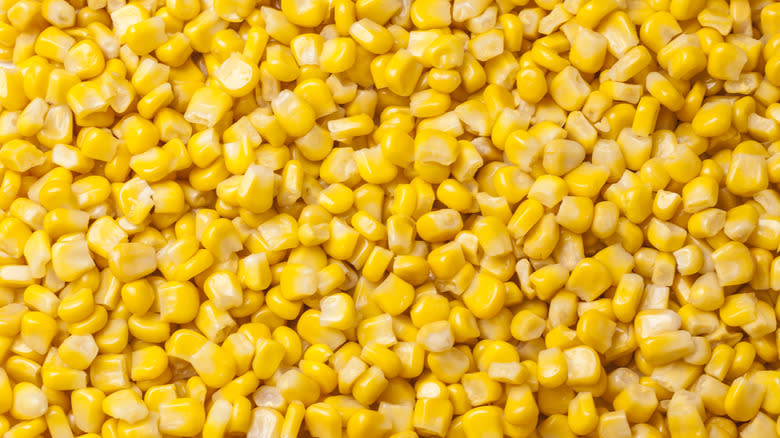
Celery can generally be relied on to supply crunch to potato salad, but its flavor can be pretty subtle. Although it has a certain savory bottom note and definitely gives the salad an extra dimension of flavor, it doesn't give much by way of sweetness. Luckily, using corn instead of celery can give that sugary element while also filling your salad with pops of moist crispness.
Corn is a great choice purely because of how easy it is to add. If you're using canned corn, there's no chopping required, and all you need to do is drain the can and throw in the kernels. Bear in mind that some canned corn varieties can be pretty high in sodium, and while that may help to season your potato salad, it can also make it too salty if you're not careful. Corn also gives your potato salad a sunny, vibrant appearance, making it the perfect addition to summer-inflected versions of the dish. If you want even more complexity, grill whole ears of corn and then slice off the kernels, creating a caramelized, nutty-sweet flavor that rounds out the flavor even more.
Instead Of Pickle Juice, Use Capers
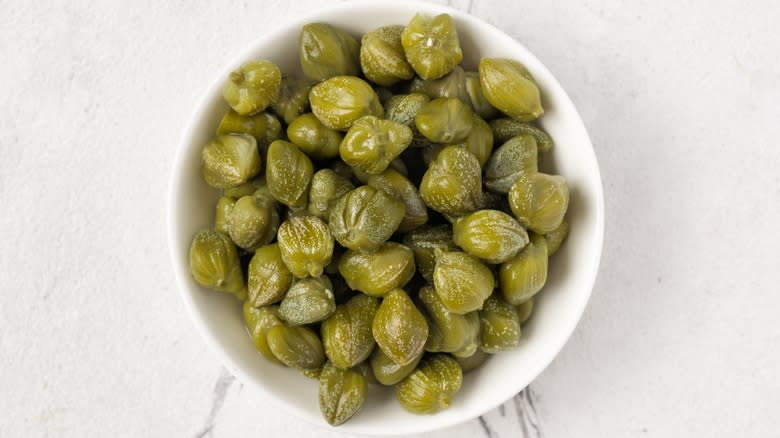
Pickle juice may not be a standard ingredient in potato salad, but those in the know are well aware of how much it adds. Pickle juice can give your salad a briny, sharp note that cuts through its creaminess and makes everything taste so much lighter and brighter. If you want the same effect with added texture, though, try capers instead. Capers bring all of the brininess of pickle juice to the party, while also adding a fragrant lemony note to the salad, and a chewy fibrous consistency that gives your dish squishy pops of flavor.
Capers can also give your potato salad an extra burst of umami, which further adds to the overall flavor profile of the dish, and which pairs excellently with the mustard, onion, and mayo. If you opt for nonpareil capers (a name for smaller-sized capers), you don't even have to do anything to prepare them: Just toss them straight in your salad. If you have slightly larger capers, you may want to chop them up a little. This will not only help them incorporate into the dressing more easily, but it will also stop them from overwhelming the dish.
Read the original article on The Daily Meal.


